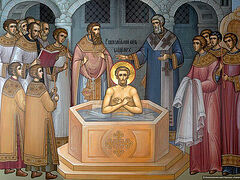On Sunday, May 25, 2025, Crimea for the first time hosted the celebration of the Day of the Baptism of Equal-to-the-Apostles St. Vladimir the Great, together with his retinue in Korsun (Chersonese). The festivities took place with the blessing of His Holiness Patriarch Kirill of Moscow and All Rus’, who established this commemoration in the liturgical calendar of the Metropolis of Crimea.
The celebration of the Day of the Baptism of Saint Prince Vladimir together with his retinue in Chersonese will now be observed annually on one of the Sundays of May at the diocesan level, without being included in the general Church calendar.
Metropolitan Tikhon called upon the hierarchs, clergy, and laity of the Metropolis of Crimea to prayerfully honor the memory of this great event and, if possible, to take part in the festivities in ancient Chersonesus.
“We, the descendants and heirs of our pious forebears who lived in the various regions and lands of our Fatherland, will always turn with special veneration to Holy Prince Vladimir, as to our godfather in the faith, with prayer for our God-protected Homeland—especially in this difficult and burdensome time. O St. Vladimir, great prince and equal to the apostles, pray to God for us! I call down upon you all the blessing of the Risen Lord and invite you to the celebration in ancient Korsun.”
A video recording of the LIturgy can be found here.
* * *
 The Baptism of Grand Prince Vladimir’s retinue (miniature from the Radzivilov Chronicles)
The Baptism of Grand Prince Vladimir’s retinue (miniature from the Radzivilov Chronicles)
The year 988 was truly a fateful year for Rus’. Grand Prince Vladimir Sviatoslavovich of Kiev did not simply choose a “state religion”, but rather determined the nation’s vector of development for many centuries to come, made the first step towards transforming the spiritual life of the country, the unity of Slavic principalities, and the gathering together of the Russian lands.
The Tale of Bygone Years testifies that at the beginning of 988, Prince Vladimir gave orders to load up 120 boats with 6000 “Varyags (Scandinavian warriors), Slovens, Krivichs1 and Bolgars2” and set off together with them south on the Dnieper River. He passed through the He crossed the rapids—most likely in the region of present-day Zaporizhzhia—descended to the river’s mouth at the site of what is now Kherson, and entered the Black Sea. From there, the fleet safely sailed along the Crimean coast, past Cape Tarkhankut, and arrived in the area of modern-day Sevastopol. The boats entered a bay now known as Streletskaya, and the army disembarked on its shore.
A few kilometers from the bay lay the objective of the military expedition—Chersonese (Korsun), a city surrounded on all sides by a wall with many towers. The wall was four meters thick and rose up to ten meters high. It is likely that the Chersonesians, seeing a large army before them, did not dare to attack the landing force and shut themselves inside the city, trusting in the strength of their fortifications. It is known that Prince Vladimir’s army approached very close to the city, within arrow range—300 to 400 meters. His warriors positioned themselves so as to cut the city off from its agricultural plots, blocking the supply of food to the fortress.
According to researchers, the location of Prince Vladimir’s camp is now traversed by the streets of modern Sevastopol—Yeroshenko, Dmitry Ulyanov, and Drevnyaya. These roads today lead from the city to the Chersonesus Historical Preserve.
Historians disagree about the duration of the siege of Chersonese (Korsun). What is known for certain is that the fall of the fortress city was due to treachery. A certain man named Anastas shot an arrow toward Prince Vladimir’s army with a note attached, indicating the location where the city’s aqueduct—running outside the fortress walls—could be dug through. The aqueduct was cut off, the defenders weakened from thirst, and surrendered.
Anastas was later given a prominent position at the prince’s court, and after Vladimir’s return to Kiev, he became abbot of the famed Church of the Tithes, which was built after Vladimir’s campaign in Crimea. Incidentally, more than a thousand years later, in May 2024, the church was destroyed by Kiev vandals.
Historians are also divided in their opinions regarding the motives behind Prince Vladimir’s bold campaign into Crimea. Some argue it was an operation to “quell a rebellion” in Korsun, carried out in agreement with the Byzantine Emperor Basil II. Others suggest it was a sudden act of “courtship” that implied a military-political alliance with Byzantium… But is the precise reason so important? In any case, Vladimir’s approach was both strategic and demonstrative. And—it worked.
The prince himself journeyed to the Byzantine possessions in Crimea, both to receive baptism there and to establish his presence in the “southern direction.” After the conquest of Korsun, priests arrived from Constantinople together with Princess Anna. They baptized the prince and betrothed him to Anna.
According to the chronicler, many of Vladimir’s warriors, prudently eager to please the prince, were baptized in Korsun when they saw that he had been baptized. Others received baptism believing that the prince’s successful storming of Cherson was a result of his baptism, by which he had gained the favor and protection of the one Greek God. These warriors quite sensibly resolved to stay close to such a rich and powerful God. According to the Nikon Chronicle, in addition to the warriors, among those baptized were also Vladimir’s “nobles”—“princes and boyars.”
As for those warriors who still hesitated, Prince Vladimir made his will known in no uncertain terms: Anyone who did not accept Christianity, “will be against me.” This argument proved decisive for many.
St. Vladimir “shepherded his land with righteousness, courage, and wisdom,” like a good and diligent steward, when necessary expanding and defending its borders by force of arms.
Well, and the Baptism in Korsun (Chersonese) of Grand Prince Vladimir and his warriors became the beginning of the Baptism of the entire Russian land.
















